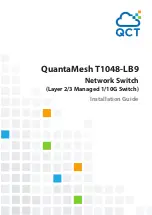
Appendix F - DGX Configuration Software
277
Enova Digital Media Switchers - Hardware Reference Manual
When a computer is directly connected to a display device, it can use the display device’s EDID information to determine
an initial compatible video signal to send. With the computer’s display controls, the user can modify this selection to
another compatible signal based on the provided EDID information.
With DVI and HDMI signals (both require EDID on the display devices), using EDID information has extended beyond
computers to other source devices, such as DVD players. As long as the source device sends a compatible signal, the
plug-and-play feature will work.
Digital Media Switchers and EDID
Digital Media Switchers, such as the Enova DGX, provide the ability to route one source signal to many potentially
different types of display devices. In almost all cases through the use of compatible DXLink Receivers (featuring
SmartScale Technology), incompatibilities between source device resolutions and displays are automatically resolved as
each receiver independently scales each source device’s video to the native resolution.
In cases where local DVI or HDMI outputs are used and a resolution incompatibility exists (or if a source device needs a
specific resolution), the DGX DVI and DGX HDMI Input Boards have the ability to update the EDID emulation file (by
updating each input’s EEPROM chip) which comes pre-loaded with an EDID set.
This EDID set consists of some of the most common EDID settings in use today, including VESA and HDTV settings
encompassing resolutions for Standard Timings and resolutions for Established Timings (for HDMI timing details, see
page 93; for DVI, see page 104). In many cases, the switcher can be used straight out of the box with no adjustments (see
"Determining the Need for EDID Re-programming" on page 277).
The DGX Configuration Software with EDID programming functionality has been provided for cases where additional in-
field programming of a board’s input connectors EDID chips is needed. The EDID Programmer view can be used for the
following:
Reading and saving EDID data in hexadecimal from an output receiving the information from its attached
destination device
Writing EDID data to the Enova DGX input connector’s associated EDID EEPROM
IMPORTANT:
Any analysis or editing of the EDID data necessary to support the equipment specific to the installation will
need to be done separately prior to using the EDID Programmer view. A variety of freeware tools can be found on the
Internet to help with these tasks.
Keep in mind that the EDID information for some equipment may not be compatible with the remaining equipment even
with re-programming. In those cases, the signals will have limited routing options.
NOTE:
If the signal from some of the equipment can only be routed to part of the destinations due to incompatible EDIDs,
control can be simplified by creating a separate virtual matrix for the inputs and outputs involved (see "Creating a New
Virtual Matrix" in the XNConnect Help file).
The remaining sections for the EDID Programmer view provide information on:
Determining the need for EDID re-programming
Reading and saving EDID data from an output, which received the information from its attached destination
device
Writing data to an Enova DGX input connector
Additional HDMI EDID files for handling audio concerns
Determining the Need for EDID Re-programming
Ideally EDID analysis will have been completed during installation specification. Consideration should be given to the use
of DXLink Output Boards and corresponding DXLink Receivers which (in almost every case) will remedy incompatible
source and destination resolution issues. If EDID analysis was not possible but all of the system’s devices are now available,
the most effective way to proceed is to test if the signal from each source device can be routed through the Enova DGX
Switcher to each of the destination devices. If they can be routed, then EDID re-programming is
not
necessary.
A method of control is not specified in the following instructions. Any board you think might need EDID re-programming
must
have the destination devices (and modules if applicable) attached before completing the following procedure.
Determining if EDID Re-programming Is Necessary
1.
Route the first input to all of the applicable outputs.
2.
Check each destination display to verify that the picture is present, making note of any that are not.
3.
Repeat Steps 1 and 2 for each of the remaining inputs.
IMPORTANT:
If any of the destinations do not display a picture, analysis or editing of the EDID data may be necessary prior
to using the EDID Programmer view in the DGX Configuration Software. A variety of freeware tools can be found on the
Internet to help with these tasks.
Board Support for DVI and HDMI Signals - Changing the EDID Setting
Another reason to reprogram EDIDs is to support different source signals on a single board. Because each input can be
changed independently (e.g., an HDMI Board can support both HDMI and DVI sources), inputs can be set up for specific
sources or for the most common source device expected to be connected.
NOTE:
HDMI-to-DVI or DVI-to-HDMI conversion requires an applicable conversion cable.
The EDID resolution and audio support variances between HDMI and DVI (which are provided as defaults) help to identify
if they need to change from the original (factory loaded) EDIDs on each input.














































